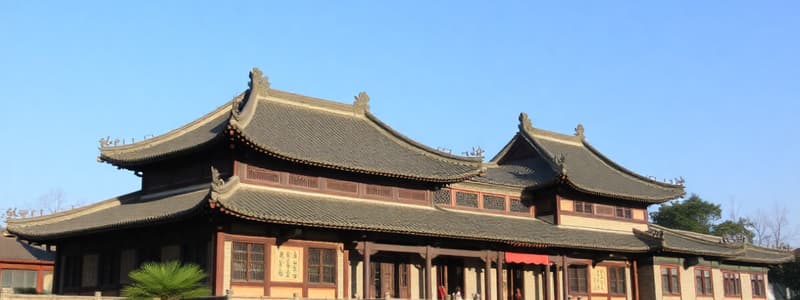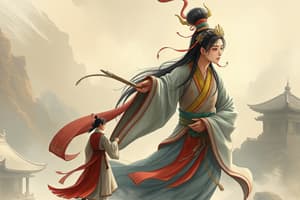Podcast
Questions and Answers
Who was the poet Li Bo and in which era did he live?
Who was the poet Li Bo and in which era did he live?
Li Bo was a poet from the Tang era in China, living from 701 to 762 C.E.
What major construction project was initiated during the Sui Dynasty?
What major construction project was initiated during the Sui Dynasty?
- Silk Road
- Great Wall of China
- Grand Canal (correct)
- Forbidden City
The Tang Dynasty lasted longer than the Sui Dynasty.
The Tang Dynasty lasted longer than the Sui Dynasty.
True (A)
Which of the following strategies did the Tang Dynasty use to maintain its power over neighboring states?
Which of the following strategies did the Tang Dynasty use to maintain its power over neighboring states?
During the Sui Dynasty, the Grand Canal was built to transport rice and other crops from the _____ River valley to northern China.
During the Sui Dynasty, the Grand Canal was built to transport rice and other crops from the _____ River valley to northern China.
What was a significant requirement for representatives from tributary states when greeting the Chinese emperor?
What was a significant requirement for representatives from tributary states when greeting the Chinese emperor?
Which emperor is known for further developing transportation during the Tang Dynasty?
Which emperor is known for further developing transportation during the Tang Dynasty?
The civil service examination during the Tang Dynasty was known for being easy.
The civil service examination during the Tang Dynasty was known for being easy.
How was the Sui Dynasty able to gain control and once again reunify China in 581 CE?
How was the Sui Dynasty able to gain control and once again reunify China in 581 CE?
What two construction projects did the Sui Dynasty focus on to bolster China both economically and militarily?
What two construction projects did the Sui Dynasty focus on to bolster China both economically and militarily?
How did the Sui Dynasty come to an end?
How did the Sui Dynasty come to an end?
What was the Chinese tributary system?
What was the Chinese tributary system?
What was the kowtow and its purpose?
What was the kowtow and its purpose?
What were some accomplishments of the Tang Dynasty?
What were some accomplishments of the Tang Dynasty?
What role did Xuanzang and the Silk Roads play in the spread of Buddhism in China?
What role did Xuanzang and the Silk Roads play in the spread of Buddhism in China?
What events led to the decline and fall of the Tang Dynasty?
What events led to the decline and fall of the Tang Dynasty?
How did the Song Dynasty compare to the Tang Dynasty geographically?
How did the Song Dynasty compare to the Tang Dynasty geographically?
Who were the scholar gentry?
Who were the scholar gentry?
What nomadic group would eventually remove the Song Dynasty from power?
What nomadic group would eventually remove the Song Dynasty from power?
What was the equal-field system that was instituted under the Tang Empire?
What was the equal-field system that was instituted under the Tang Empire?
What new methods of production helped increase Chinese agricultural yields?
What new methods of production helped increase Chinese agricultural yields?
Why was the introduction of Champa rice to China important?
Why was the introduction of Champa rice to China important?
What is proto-industrialization?
What is proto-industrialization?
What Chinese philosophy was at the heart of the creation of gunpowder?
What Chinese philosophy was at the heart of the creation of gunpowder?
Flashcards are hidden until you start studying
Study Notes
Postclassical Period: Tang and Song Dynasties
- China experienced a golden age during the Tang and Song dynasties (600 years).
- During this period, China experienced wealth, political stability, and artistic achievements.
- China dominated East Asia, influencing neighboring Korea, Japan, and Vietnam.
Political Structures in China
- The Han Dynasty collapsed in the 3rd century CE, leading to 400 years of anarchy.
- The Sui Dynasty (581-618 CE) briefly reunited China through violence and repression.
- Emperor Sui Yangdi expanded Chinese control through military campaigns in Korea and Central Asia.
- The Sui Dynasty is notable for the construction of the Grand Canal, connecting the Yangtze River valley to northern China.
- The Sui Dynasty used conscripted labor for the Grand Canal and the strengthening of the "Long Wall" (future Great Wall).
- The Sui Dynasty fell due to high taxes, forced labor, and the emperor's dictatorial rule.
Tang Dynasty:
- The Tang Dynasty (618-907 CE) succeeded the Sui Dynasty, ushering in a period of prosperity and stability.
- The Tang Dynasty expanded its territory to Central Asia, Manchuria, and Vietnam.
- The Tang Dynasty established the tributary system, where neighboring states paid tribute to the Chinese emperor, acknowledging Chinese dominance.
- The tributary system cemented China's economic and political power, fostered stability, and stimulated trade.
- The Tang Dynasty required envoys from tributary states to perform the "kowtow" ceremony, bowing their head to the floor as a sign of respect to the emperor.
- Tang Taizong (ruled 627-649) further developed transportation, including roads, canals, postal services, and reduced bandit activity.
- The Tang Dynasty expanded its bureaucracy, requiring rigorous civil service examinations.
- The civil service examination system emphasized education, fostering economic growth and cultural development in China.
Other Points
- The poem by Li Bo (701-762 CE) reflects the positive and uplifting themes of the Tang era.
Sui Dynasty (581-618 CE)
- Reunified China after centuries of division
- Used a large and disciplined military to achieve unification
- Focused on two major construction projects:
- Grand Canal: Linked north and south China, facilitating trade and transportation
- Great Wall: Strengthened northern defenses against nomadic threats
- Overspending on infrastructure and military campaigns led to its downfall
Tang Dynasty (618-907 CE)
- Established a tributary system, asserting Chinese dominance over neighboring states like Korea, Japan, and Vietnam.
- Introduced the kowtow, a ritual of respect and submission to the emperor, reinforcing the central authority.
- Achieved numerous accomplishments, including:
- Economic prosperity fueled by agricultural advancements and international trade
- Expansion of the Silk Road, connecting China with the West
- The spread of Buddhism in China was facilitated by figures like Xuanzang, who travelled to India and brought back Buddhist scriptures.
- Suffered a decline due to:
- Rebellions led by regional warlords
- Internal power struggles
- The influence of nomadic Uighur tribes
Song Dynasty (960-1279 CE)
- Focused on internal development rather than territorial expansion.
- Established a complex bureaucracy with a powerful scholar gentry class.
- Experienced significant economic growth due to:
- Expansion of trade and improved agricultural practices
- Increased use of paper currency, known as "flying money"
- Ultimately overthrown by the nomadic Jurchen people, who established the Jin dynasty.
Economic Developments in Post-Classical China
- The equal-field system aimed for more equitable land distribution during the Tang and Song Dynasties, boosting agricultural production.
- New agricultural techniques like the use of iron tools, improved irrigation, and the introduction of Champa rice from Vietnam significantly increased food yields.
- The rise of proto-industrialization, characterized by specialized labor and the production of goods for a market, emerged with the creation of porcelain and silk.
- Gunpowder, a Chinese invention rooted in Daoist alchemy, revolutionized warfare.
- The flourishing of the Silk Road led to the growth of prominent cities like Guangzhou and Quanzhou.
Studying That Suits You
Use AI to generate personalized quizzes and flashcards to suit your learning preferences.




